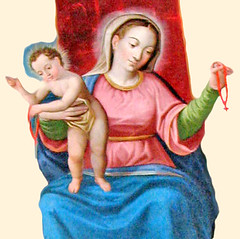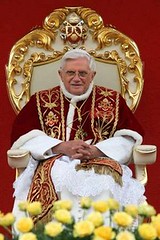The Beloved Disciple
 St John, the beloved disciple, who was closest to the Lord and reclined his head upon Christ's breast during the Last Supper, is found in close proximity to the Lord liturgically. His feast is celebrated within the Octave of Christmas and the first and only apostle to be so honoured, perhaps as a mark of the special love of Christ for him. "Hence he is called the grace of God, because to the Lord he was graced", says Jacobus de Voragine.
St John, the beloved disciple, who was closest to the Lord and reclined his head upon Christ's breast during the Last Supper, is found in close proximity to the Lord liturgically. His feast is celebrated within the Octave of Christmas and the first and only apostle to be so honoured, perhaps as a mark of the special love of Christ for him. "Hence he is called the grace of God, because to the Lord he was graced", says Jacobus de Voragine.The eagle - representing the fourth of the living creatures about the throne of God (Rev 4:6-8) - is one of the symbols of St John and it is often said that this represents the soaring thought of John's Prologue to his Gospel and the high theology found in John's Gospel. This may have some basis in the following story about St John that is found in the 'Golden Legend':
"Someone gave a live partridge to the blessed John (as Cassian tells us in his 'Conferences'), and he gently held and stroked the bird. Seeing this, a boy laughed and called to his companions: 'Come and watch this old man playing with a little bird like a child!' The saint, knowing by the Spirit what was going on called him and asked what it was that the youngster held in his hand. The boy said that it was a bow, and John asked what he did with it. The answer was: ' We shoot birds and animals!' Then the lad stretched his bow and held it taut in his hand, but when the apostle said nothing, he loosened it. John asked him why he loosened the bowstring, and he replied: 'Because if you keep it stretched too long, it gets to weak to shoot the arrows.' So John told him: 'That's how it is with human fragility: we would have less strength for contemplation if we never relaxed and refused to give in now and then to our own weakness. So too the eagle, which flies higher than any other bird and looks straight into the sun, yet by its nature must come down again; and the human spirit, after it rests awhile from contemplation, is refreshed and returns more ardently to heavenly thoughts.'"
The story is remarkable because John's description of the eagle is also used to describe his theology, which soars to the heights of Divinity and penetrates to the mystical depths of the Son; hence the attribution of the eagle as the symbol of his Gospel. However, there is also the humane and sound spiritual advice that St John gives to the child. In these days after the busy-ness of Christmas and the liturgical heights of the Feast, we would do well to relax a little from the rigours of our life; here in Blackfriars, we have a reduced schedule of choral Offices until the New Year. The reference to hunting in the story is also co-incidental but timely because on Boxing day (yesterday), the Hunting season begins in the United Kingdom.
Among other local customs, it is said that in Germany and Austria, it is customary to bring a quantity of wine to church to be blessed by the priest. This Johannissegen is then taken away and drunk at home and it is said to have curative and protective properties! In the 16th and 17th-centuries, there was a great drinking of wine on St John's day, often to excess... This association with wine may be due to the legend that St John drank a chalice of poisoned wine but was not overcome by it.
St John is said to have worked with St Peter and then settled in Ephesus (hence the tradition that the house of Our Lady, whom the Lord placed in John's care, is in Ephesus) where he died in the reign of Trajan (98 - 117). He is thought to have died peacefully in about the third year of Trajan, being then about ninety-four years old. He seems to have outlived all the other apostles, and he is the only one of whom it is certain that he did not die a martyr.
St Jerome recounts a tradition that, when age and weakness made it impossible for John to preach to the people, he would have himself carried down to the assembly of the faithful and would say only: "My little children, love one another." When they asked him why he always used the same words, he said, "Because it is the word of the Lord, and if you keep it, you do enough." The Holy Father, Pope Benedict XVI's first Encyclical, "Deus caritas est", 'God is Love', was signed on Christmas day and will be published in the new year. It is reportedly a meditation on this simple message of St John which we find in his first letter: "Beloved, let us love one another, because love is from God... God is love, and those who abide in love abide in God, and God abides in them" (1 Jn 4:7, 16b). We do well to keep St John's words in our hearts and let us especially ponder this mystery as we celebrate the Incarnation of Love, Jesus Christ.
The image of St John the Evangelist above is from the Lindisfarne Gospels.







0 Comments:
Post a Comment
<< Home